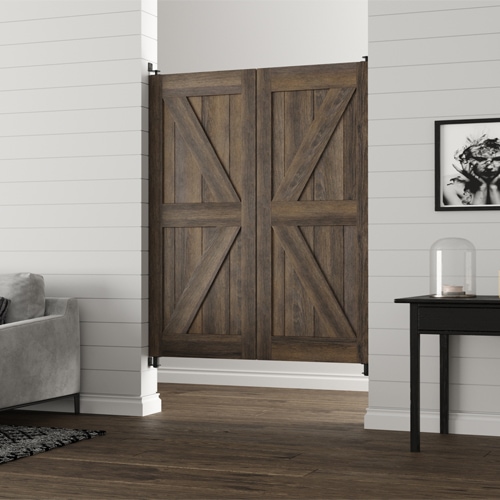
Enhancing Thermal Performance in Buildings with Louvered Doors
Enhancing Thermal Performance in Buildings with Louvered Doors
Sustainability isn't just a buzzword. It's a call to action to ensure our future is greener, more efficient, and less impactful on the planet. As we strive for energy efficiency, one often-overlooked solution within our walls is the humble door, specifically, the louvered variety.
In this comprehensive guide, we'll dive into how louvered doors can significantly enhance a building's thermal performance. This long-form content is not just another blog post; it’s a resource for business owners, renewable energy enthusiasts, and sustainable living advocates looking to make a tangible difference in energy use.
Introduction: The Urgency of Energy Efficiency

Buildings are one of the largest consumers of energy in the world. From cooling to heating, they account for nearly 40% of global energy usage. Optimizing our buildings for energy efficiency is a crucial step towards a more sustainable future. And when it comes to small yet meaningful changes, the type of doors we use can make a big difference.
Understanding Thermal Performance
Before we can comprehend how louvered doors improve thermal efficiency, it's essential to grasp what 'thermal performance' really means. Thermal performance refers to the ability of a building component to maintain an even temperature inside, regardless of the outside climate. It's influenced by factors such as insulation, air leakage, and solar heat gain.
What Affects Thermal Performance?
Several key elements within a building can either positively or negatively impact its thermal performance. These include:
- Insulation Levels: More insulation typically means a better ability to retain or repel heat as required.
- Windows and Glazing: Importance of the right type of glazing to control solar heat gain.
- Air Sealing: The reduction of drafts and leaks, which can let cold air in and warm air out.
- Building Orientation: Positioning and building design can harness natural heating and cooling.
Benefits of Louvered Doors in Thermoregulation
Louvered doors present a unique set of advantages that play a significant role in managing a building's warmth and coolness. Traditionally associated with tropical or coastal aesthetics, these doors are now emerging as a choice for energy-conscious homeowners.

Improved Ventilation and Airflow
In warmer temperatures, louvered doors can be left partially open, allowing for improved air circulation. This natural ventilation can cool rooms without the need for fans or air conditioning, reducing the overall energy load.
Natural Light and Solar Heat Gain
The design of louvered doors is perfect for maximizing natural light and moderate solar heat gain, particularly in cooler climates. The ability to adjust the slats means you can let in sunlight during the day, keeping spaces warm without turning up the heater.
Privacy and Security without Compromise
Louvers can be tilted to maintain privacy while still ensuring some visibility and airflow. This balance lets homeowners and business owners secure their properties without sacrificing the benefits of weather and temperature regulation.
Aesthetics and Design Options
Louvered doors come in a variety of styles, making it easy to integrate them into almost any architectural design. They add a touch of aesthetic versatility that can complement modern or traditional home styles with ease.
Integration with Other Sustainable Solutions
Louvered doors are most efficient when part of a holistic approach to energy management. This could involve pairing them with other sustainable building techniques, like using them in conjunction with passive solar design to maximize their benefits.
Case Studies and Real-Life Examples
Now, let's delve into some real-world applications of louvered doors in enhancing a building's thermal performance.
Residential Home in California
A coastal home in California used louvered doors to capitalize on ocean breezes, significantly reducing the need for air conditioning. By allowing for natural ventilation, the home enjoyed improved air quality and a lower carbon footprint.
Office Building Adaptation
An office in a particularly sunny clime opted for louvered doors to control heat gain from the strong, daily sunlight. This reduced the strain on their HVAC systems during peak hours, resulting in measurable energy savings.
Tips for Choosing and Installing Louvered Doors

For those considering louvered doors as part of an energy-efficient plan, here's a guide to selecting and setting them up properly.
Homeowner Considerations
Homeowners should reflect on the overall energy demands and climate challenges of their area. From there, considerations include the look and feel of the door, the level of control required, and potential trade-offs in insulation for ventilation.
Professional Installation Guidance
Builders and renovators play a crucial role in the successful use of louvered doors. Understanding the importance of sealing, proper installation techniques, and local building codes will ensure these doors meet functional and energy efficiency requirements.
Conclusion: Taking the Right Step Towards Energy Efficiency
As we conclude this exploration, we emphasize the significant role louvered doors can play in maximizing energy efficiency in our buildings. Their ability to regulate temperature, enhance natural light, and complement eco-friendly designs is a testament to their potential impact.
For those committed to sustainable living, the journey is ongoing. Louvered doors are just one example of how small choices can lead to more significant, positive effects on our environment. We encourage you to continue seeking out innovative, green solutions and incorporating them into your lifestyle and property.
As you venture forth on your path to energy efficiency, consider the noticeable difference louvered doors could make. It's a simple step that speaks volumes for the future of sustainable living.
